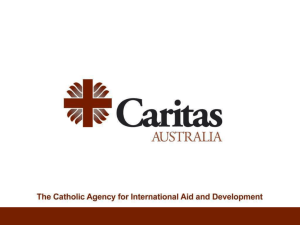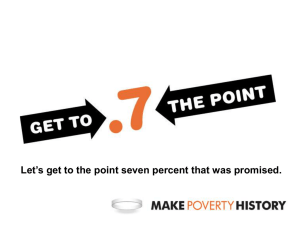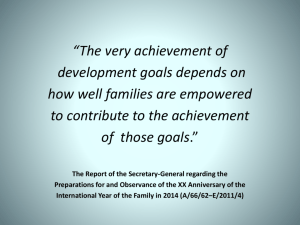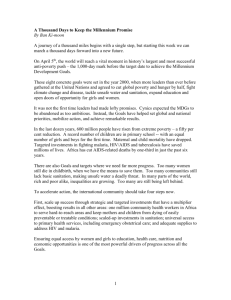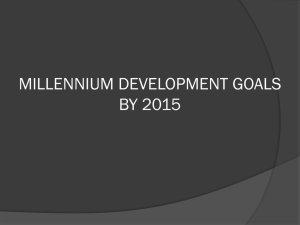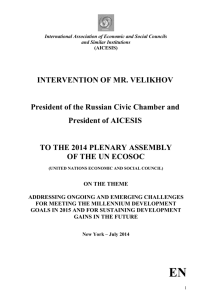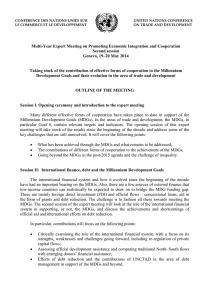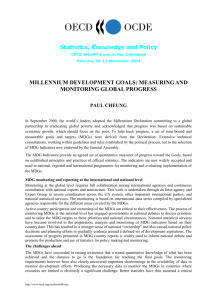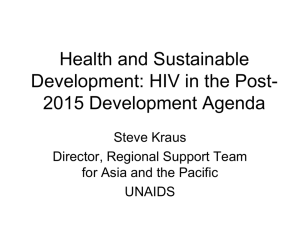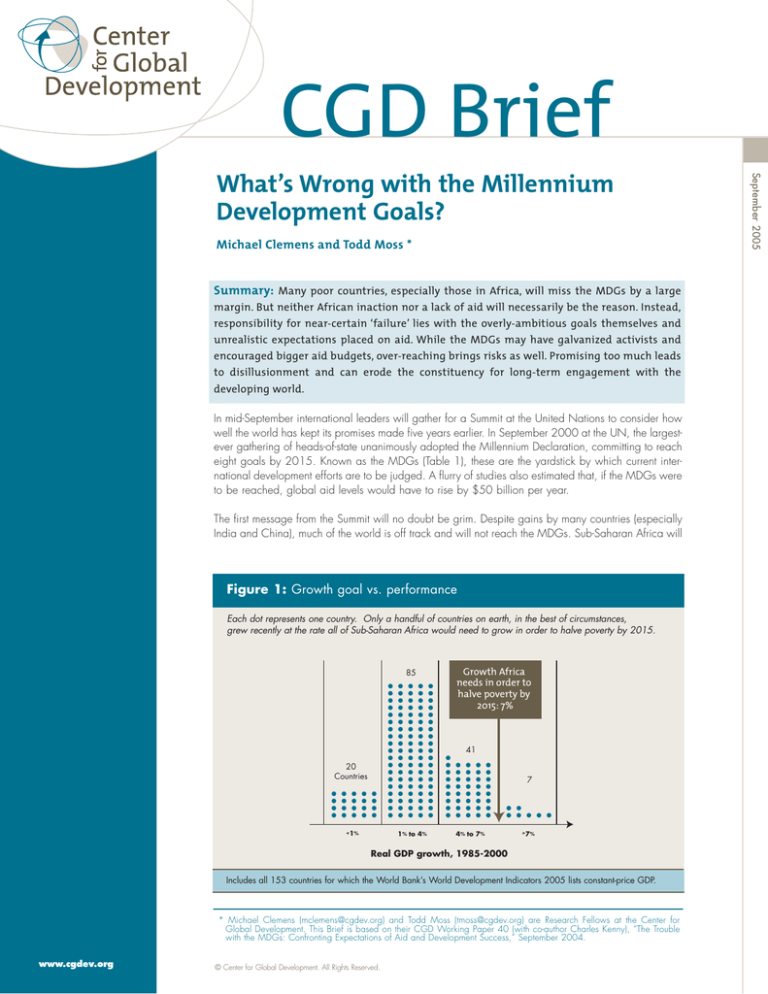
CGD Brief
Michael Clemens and Todd Moss *
Summary: Many poor countries, especially those in Africa, will miss the MDGs by a large
margin. But neither African inaction nor a lack of aid will necessarily be the reason. Instead,
responsibility for near-certain ‘failure’ lies with the overly-ambitious goals themselves and
unrealistic expectations placed on aid. While the MDGs may have galvanized activists and
encouraged bigger aid budgets, over-reaching brings risks as well. Promising too much leads
to disillusionment and can erode the constituency for long-term engagement with the
developing world.
In mid-September international leaders will gather for a Summit at the United Nations to consider how
well the world has kept its promises made five years earlier. In September 2000 at the UN, the largestever gathering of heads-of-state unanimously adopted the Millennium Declaration, committing to reach
eight goals by 2015. Known as the MDGs (Table 1), these are the yardstick by which current international development efforts are to be judged. A flurry of studies also estimated that, if the MDGs were
to be reached, global aid levels would have to rise by $50 billion per year.
The first message from the Summit will no doubt be grim. Despite gains by many countries (especially
India and China), much of the world is off track and will not reach the MDGs. Sub-Saharan Africa will
Figure 1: Growth goal vs. performance
Each dot represents one country. Only a handful of countries on earth, in the best of circumstances,
grew recently at the rate all of Sub-Saharan Africa would need to grow in order to halve poverty by 2015.
85
Growth Africa
needs in order to
halve poverty by
2015: 7%
41
20
Countries
7
<1%
1% to 4%
4% to 7%
>7%
Real GDP growth, 1985-2000
Includes all 153 countries for which the World Bank’s World Development Indicators 2005 lists constant-price GDP.
* Michael Clemens (mclemens@cgdev.org) and Todd Moss (tmoss@cgdev.org) are Research Fellows at the Center for
Global Development. This Brief is based on their CGD Working Paper 40 (with co-author Charles Kenny), “The Trouble
with the MDGs: Confronting Expectations of Aid and Development Success,” September 2004.
www.cgdev.org
© Center for Global Development. All Rights Reserved.
September 2005
What’s Wrong with the Millennium
Development Goals?
probably miss them by a wide margin. Indeed, if things do not
change radically, the number of Africans living in poverty may
actually increase, while more than two dozen African countries
may not even reach 50% primary school completion in time.
This apparently bleak state of affairs will lead to the
second message from the Summit: that more aid is needed. Even
though global aid rose from $53 billion in 2000 to $79 billion
in 2004, the increases have been slow in coming and less than
the hoped-for doubling. In fact, the lack of progress in meeting
the MDGs will be used to demand more aid sooner and possibly
to justify implementing proposals to tax international airline tickets
or to borrow from private capital markets. But are the goals really
achievable? Are the expectations of what more aid can do realistic? If not, is the aid community setting up Africa, and themselves, for failure?
inadvertently create
an illusion that any
Even if aid boosts growth a
goal can be met, if
only the right amount
little, more aid cannot make
of money can be
Africa grow like China.
mobilized. Among
development experts,
however, it is widely
accepted that resources are not the sole—and perhaps not even
the most important—constraint to meeting the MDGs.
No amount of aid will make Africa grow at 7%. A huge literature
looks at the link between aid and economic growth, and the
results are not overly promising. Even those studies that do show
aid can cause growth (for example, certain kinds of aid or that
given to countries with good policies), also show very steep diminishing returns to additional aid. That is, even if aid boosts growth
a little, more aid cannot make Africa grow like China.
Are the MDGs practical targets?
The MDGs are laudable and undoubtedly well-intentioned. But
that does not mean they are realistic for all countries. Based on the
actual rates of progress for both rich and poor countries in the
past, the MDGs are now asking many countries to perform at the
top end of historical experience. Indeed, in a few cases the bar
for the world’s poorest countries is now set well above any historical experience. To take just a few examples:
Goal 1: Halving poverty. African economies must grow at about
7% per year over 2000-2015 in order to halve the number of
people living below the poverty line. Just seven out of 153
countries for which we have data accomplished this feat in the
preceding 15 years (Figure 1). Of those seven, only two were
African: Botswana, and Equatorial Guinea, neither of which are
easily replicable.
Goal 2: Universal primary school completion. Many countries are
starting from such a low level that they must now attain in about a
decade what rich countries took nearly a century to complete. At
least 20 African countries have primary school enrollment of
70% or less, but to reach 100% by 2015 is enormously ambitious
if history is any guide (Figure 2).
Goal 4: Decrease child mortality by two thirds. If the same goal
had been set in 1975, only one poor country in the world
(Indonesia) would have met the goal (Figure 3).
Can more aid achieve them?
The studies suggesting $50 billion more is needed each year
are frequently misinterpreted and contribute to an excessive—
and unhelpful—focus on aid. All of the studies have significant
problems with the methods used to arrive at the bottom line.
The more careful ones come with caveats, but these tend to
get lost once advocates or the media get hold of them. More
importantly, by putting a price tag on outcomes, cost estimates
In the social sectors it is also already well known that more money
often does not translate into results; more health spending does not
necessarily mean better health. This is because of deep
structural problems in local health and education systems that aid
projects have a poor record of rapidly removing. The effectiveness
of aid is at times also undermined by the way donors operate.
Most importantly, the weak link between spending and
services exists also because health and education do not occur in
a vacuum, but rather in a broader economic environment.
It may be an uncomfortable truth, but even something as basic as
primary education still has a demand side. The desire of
parents to keep their children in school is affected not only by the
availability and quality of schools, but also by a range of incentives linked to cultural preferences, family circumstances, and
wider changes in the economy. Knowing the cost of putting several
million children through school may be useful, but it is not the same
as knowing how to actually get them in school.
Figure 2: Education goal vs. performance
100
Net primary enrollment
What’s Wrong with the MDGs?
2
MDG
Historical Best
(e.g.,Korea)
90
Typical country
1960-2000
80
Today’s rich
countries,19th century
70
60
2000 2005 2010 2015 2020 2025 2030 2035
Year
What might be the downside?
But there is a long history of setting international development
goals. In the 1960s the UN set its sights on universal primary
education by 1980, and in 1980 it committed to 6.5% economic
growth throughout the developing world by 1990—among many,
many others. Through the 1980s and 1990s there was
growth, poverty reduction, improved schooling, and much else to
The MDGs could turn real
celebrate throughout
development successes into
the large majority of
imaginary failures.
the developing world,
but
did
anyone
notice? These impossible goals focused attention far away from what was accomplished
through sound domestic policies, aid, and other forms of cooperation. The latest round of unattainable goals will do so again. That’s
bad for poor people and bad for the development community.
The excessive focus on aid is also potentially risky. Aid can
and will play a role in improving the lives of the world’s poor.
But another $50 billion or even $100 billion more, cannot
achieve the MDGs. If lots more money does appear, unrealistic
promises will undercut much of the rationale for aid and bolster
those who claim aid is a waste. If huge increases in aid do not
materialize, then poor countries will complain that rich countries
have not lived up to their end of the MDG bargain.
What now?
Indeed, there is a real risk that the MDGs, as currently conceived
and promoted, could turn real development successes into imaginary failures. Creating targets such as the MDGs may help to
rejuvenate the aid debate and energize the development
community. But there is also a danger that the MDGs, by creating
utopian expectations of what can be achieved quickly, will create
unnecessary impressions of failure.
Burkina Faso, for instance, has net primary school enrollment of
around 40 to 45%. Should it be termed success or failure if wise
Figure 3: Child mortality goal vs.
Decrease in child mortality
1975-2000 performance
Lowest
income
Fast enough
to meet goal
32
Not fast
enough
29
Accept that it is not feasible for most countries to reach most of
the MDGs, especially in Africa;
Stop misusing costing studies as evidence that we can purchase
outcomes with more aid (the studies themselves explicitly make
no such claim);
Consider new ways of recognizing real success at the
country level rather than in global targets;
Avoid these problems with the next round of goals—yes, there
will be more—by basing them on where countries are and on
reasonable expectations of performance.
Conclusion
Middle to
upper income
1
The MDGs, despite these risks, are not going away. The UN, its
members governments, and the donor community should:
47
The vast majority of developing countries will miss most of the
MDG targets in 2015. Nearly all African countries will miss most
of them. But this will not be a sign that poor countries have failed,
or that aid has been a waste. Nor will it primarily be because
donors did not spend the right amount of money.
At the same time, many of the world’s poorest countries will in all
likelihood make great progress in improving the quality of life of
their people—and aid will almost certainly have played a crucial
part. It would be a shame if the MDGs, in trying to make the case
that the world can and should help the world’s poor, wound up
3
September 2005
A literal interpretation of the MDGs accepts the goals as real
targets. A more nuanced view might see the MDGs as a symbol of
the kinds of outcomes toward which the world should strive. This
view takes the MDGs as a tool, not a practical target. Goals generate discussion,focus attention, and help assign accountability. The
MDGs have doubtlessly served these purposes to some degree.
governance, aid,
and other types of
engagement allow
We need to invest in
the country to reach
vaccines, open our markets,
only 60% enrollment
and arrange for win-win
by 2015? Such a
labor mobility. Development
feat
would
be
extraordinary
by
is a marathon, not a sprint.
historical standards,
but a patent failure
according to the
MDGs. It took the United States over a century to make the
transition from Burkina Faso’s current enrollment rate to universal
primary schooling. Would it not energize the development
community more to celebrate Burkina Faso’s performance than to
condemn it as disaster?
undermining the cause by over-reaching on the targets and
overselling the efficacy of aid.
What poor countries need from rich ones is broad-based,
sustained, moderate engagement—not emotional, moralistic,
centralized big bangs. Aid can work, but it must be dramatically improved. Innovations like the Global Health Fund or the
Millennium Challenge Account are a great start, but we need
much more such experimentation and evaluation before
“scaling up” makes any sense. And we need to go far beyond
aid, investing in key technologies (such as vaccines), opening
our markets, finding creative arrangements for win-win labor
mobility, and many other avenues to support ongoing efforts by
poor countries themselves.
But development is a marathon, not a sprint. In a democratic
society, the only way to build support for the long haul is to
nurture a constituency by showing the public that good things
happen in Africa and other very poor places. The MDGs simply
will not do this. They were designed, in fact, to do the opposite.
Table 1: The Millennium Development Goals
Goal
Targets for 2015 (from 1990 level)
Halve the fraction of those with income < $1/day
1 Poverty
Halve fraction of people who suffer from hunger
The
2 Education
Universal primary schooling completion
3 Gender equality
Eliminate gender disparity in schooling (preferably by 2005)
4 Child mortality
Reduce the under-five mortality rate by 2/3
5 Maternal health
Reduce the maternal mortality rate by 3/4
6 Disease
Halt and begin to reverse spread of HIV/AIDS, malaria and other major diseases
7 Environment
Halve the ratio of people without access to safe drinking water and basic sanitation
8 Global partnership
7 targets related to: trade, debt, youth, technology, drugs affordability, and special needs.
Center for Global Development is an independent, non-partisan, non-profit think tank
dedicated to reducing global poverty and inequality through policy oriented research and active
engagement on development issues with the policy community and the public. A principal focus of
the Center’s work is the policies of the United States and other industrialized countries that affect
development prospects in poor countries. The Center’s
research assesses the impact on poor people
of globalization and of the policies of governments and multilateral institutions. In collaboration with civil
society groups, the Center seeks to identify
policy alternatives that will promote equitable growth
and participatory development in low-income and transitional economies. The Center works with other
institutions to improve
public understanding in industrialized countries of the economic, political,
and strategic benefits of promoting improved living standards and governance in developing countries.

